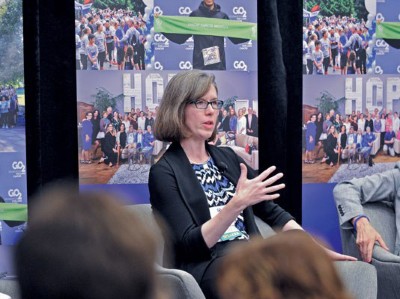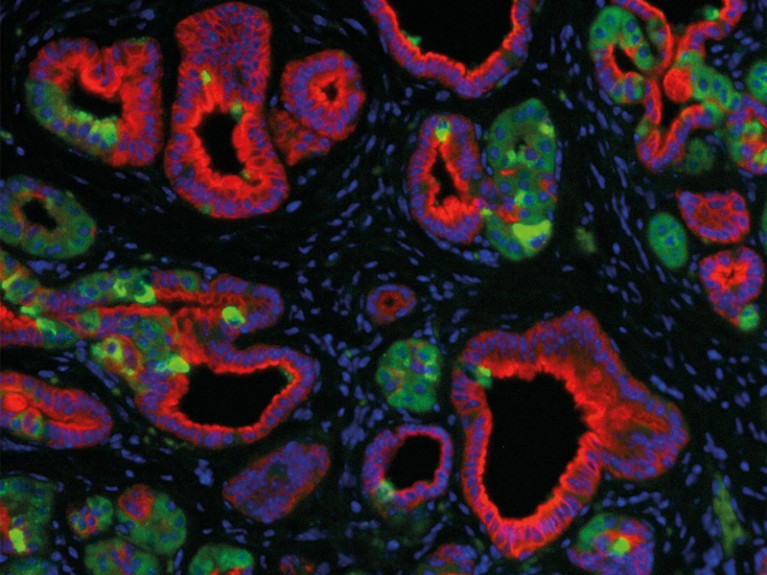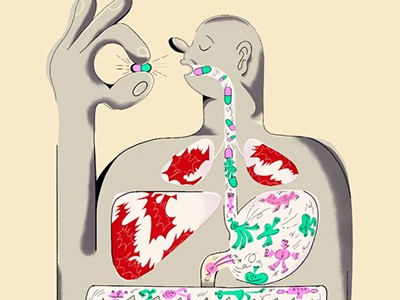When Terri Conneran, a mother-of-three and a former corporate accountant in Charlotte, North Carolina, was diagnosed with lung cancer in 2017, she sought support from people going through the same thing. A handful of groups had been springing up on social media based on the specific mutations found in people’s tumours.
But Conneran was dismayed to find no such group for the defining mutation in her cancer, in a gene called KRAS, which is mutated in about one-quarter of all tumours. Part of the reason might have been the absence of drugs targeted to mutations in this gene. “People in the know said that KRAS is undruggable,” says Conneran. So she started a group of her own, the KRAS Kickers, and happened to do so at an opportune time.
Last year, the US Food and Drug Administration approved the first KRAS-targeted cancer therapy — sotorasib (Lumakras), made by the biotechnology firm Amgen in Thousand Oaks, California. “It is hope in a pill,” says Conneran, who has received funding from the pharmaceutical industry to support her group. “We have patients alive today as a result.” A second KRAS-targeted drug is expected to be approved this year.
Although sotorasib’s approval was a landmark, the drug targets only one specific mutation in the KRAS protein, and its effects are transient: most people who initially respond relapse a few months later. On 12 September, Amgen announced that the latest trial of sotorasib found that it extended progression-free survival — a measure of the time elapsed without the cancer worsening — only by about one month longer than standard chemotherapy. Only 28% of the participants treated with sotorasib responded to it. That’s roughly twice the number who responded to the standard chemotherapy, but a sign nonetheless that most people who have KRAS-positive lung cancers will not be helped by the new drug.
Even so, the pace of KRAS research and the pursuit of KRAS-targeting drugs has never been so energized, says cancer biologist Channing Der at the University of North Carolina in Chapel Hill. The first glimpse of success has shown that it is possible to drug the ‘undruggable’ KRAS, and now researchers in academia and industry are developing ways to improve their approach. “I have never seen this level of excitement and buzz in the entire history of the field,” he says. “The level now is insane.”
Deadly mutation
The KRAS protein sits at the centre of a spiderweb of crucial cellular pathways. It has a role in governing cell proliferation, cell death and many things in between. The KRAS protein cycles between two conformations, switching from an ‘off’ state to an ‘on’ state when it binds to the signalling molecule GTP. Mutations associated with cancer make the protein more likely to linger in its ‘on’ state, and can be found in nearly every type of tumour. Such mutations are particularly prevalent in some of the deadliest cancers: more than 80% of pancreatic cancers carry a KRAS mutation, for example, as do roughly 30% of lung adenocarcinomas and colorectal tumours.

Oncogene-specific advocacy groups bring a patient-centric perspective to studies of lung cancer
Both sotorosib and an as-yet-unapproved drug called adagrasib — made by Mirati Therapeutics in San Diego, California — target tumours by attaching to KRAS proteins that contain a mutation called G12C. This variant replaces the twelfth amino acid in KRAS, normally a glycine (G), with a cysteine (C). It is the most common KRAS mutant found in lung tumours, but is not the most prevalent KRAS mutation overall: most KRAS-mutant cancers, including Conneran’s, have a different mutation at the same location, called G12D.
This means that most people with KRAS-mutant cancers still don’t have a therapy targeted to their mutation. Conneran feels the frustration from support-group members. “It’s the most common question,” she says. “‘How come the G12C drugs don’t work for me? I’m only one letter off.’”
Another problem is the drug’s patchy, short-lived response. Clinical trials have so far been conducted in people with advanced KRAS-driven cancers that did not respond to other therapies. In these participants, treatment with sotorasib halts tumour growth for just over six months1. Less than one-third of people with a form of G12C lung cancer and less than one-tenth of people with G12C colorectal cancer respond to treatment with sotorasib2. After treatment, many tumours become resistant to the drug. “Because it’s been so difficult to inhibit KRAS, our enthusiasm has actually been disproportional to the data itself,” says oncologist Alex Adjei at the Cleveland Clinic in Ohio.
On a high
Still, that initial success in drugging G12C has energized the field (see ‘KRAS inhibitors on trial’). Some of the buzz comes from renewed hope that drugs can be found to target other KRAS mutations, including G12D. The decision to target G12C was pivotal to sotorasib’s success, says Kevan Shokat, a chemical biologist at the University of California, San Francisco, whose laboratory laid the foundation for sotorasib in 20133. Shokat also co-founded Revolution Medicines, a company in Redwood City, California, that is developing therapies to inhibit KRAS. Cysteine is more chemically reactive than many amino acids, making it easier to design a drug that would bind to it.
KRAS inhibitors on trial
Dozens of trials for drugs that target the KRAS protein have been registered at clinicaltrials.gov, a US-based registry. The majority are for cancers that carry the G12C mutation, but some groups are beginning to test G12D-targeted drugs and other approaches.
|
Drug |
Target |
Manufacturer, country |
Number of trials |
Status |
|---|---|---|---|---|
|
Sotorasib |
G12C (targets ‘off’ state of the mutant protein) |
Amgen, USA |
31 |
Already approved for treatment of non-small-cell lung cancer. |
|
Adagrasib |
G12C |
Mirati Therapeutics, USA |
14 |
Phase III trials comparing the compound with other drugs are under way. |
|
JAB-21822 |
G12C |
Jacobio Pharmaceuticals, China |
5 |
Phase I/II trials commencing across several sites in the United States and China. |
|
D-1553 |
G12C |
InventisBio, China |
4 |
Phase I/II trials commencing worldwide. |
|
HRS-4642 |
G12D |
Jiangsu Hengrui Medicine, China |
1 |
Phase I trial not yet recruiting. |
|
ASP3082 |
G12D |
Astellas Pharma, Japan |
1 |
Phase I trial commencing at several US sites. |
|
RMC-6236 |
Multiple RAS mutations (targets protein ‘on’ state) |
Revolution Medicines, USA |
1 |
Trial excludes people with a G12C mutation. |
With molecules capable of fitting into the tiny pocket in the protein’s 3D structure to bind that cysteine, researchers have a starting point from which to design drugs that could bind to other amino acids, says cancer biologist Frank McCormick, also at the University of California, San Francisco, and a co-founder of Bridge Bio in Palo Alto, California, which is also developing KRAS inhibitors. Scientists are also searching for molecules that can bind to different forms of the protein as it cycles between its on and off states. Sotorasib binds specifically to the off form, which could limit its effectiveness. “The KRAS G12C story has told us that you can probably drug other undruggables if you have a phenomenal chemist,” says Patricia LoRusso, an oncologist at Yale School of Medicine in New Haven, Connecticut. “However, it’s not good enough to just drug it – you have to take it one step beyond.”
In 2021, researchers at Mirati reported4 a compound called MRTX1133 that binds to G12D, but chemical properties of the molecule made it difficult to administer as a drug, says McCormick. The company has reformulated the compound and is planning to launch clinical trials. Even if those are not successful, the original molecule has been a pivotal tool for researchers to explore ways of inhibiting the mutant, he says. “That was another big jump in the field.”

Many cancer drugs aim at the wrong molecular targets
Sotorasib’s selectivity for mutant KRAS could be a safety advantage: because KRAS is involved in so many crucial cellular pathways, many researchers worried that a drug that inhibits normal KRAS would be toxic. But despite those potential concerns, some researchers are exploring drugs that turn off all KRAS proteins, mutant and wild type alike.
Unpublished data in mice suggest that doing so could be safe — cells can recruit related proteins called NRAS and HRAS to fill in for some functions of the blocked KRAS protein. “The big question is ‘does wild type matter?’” says McCormick. “But most people are not too worried about it.”
NRAS and HRAS might help KRAS-mutant tumours to circumvent the effect of drugs such as sotorasib, leading some researchers to explore ‘pan-RAS inhibitors’ that block all three proteins. There is debate around whether these would be safe, says lung cancer specialist Kwok-Kin Wong at New York University Langone Health in New York City. “Everybody and their grandmother is really anticipating what’s going to happen,” he says. “There has to be some cost, I just don’t know what it’s going to be.”

Meanwhile, efforts to make G12C inhibitors more effective by combining them with other cancer drugs are under way, but yielding mixed results. Researchers were particularly optimistic about a combination of sotorasib and drugs that unleash the immune system against tumours, called checkpoint inhibitors. Preclinical data5 in mice suggested that the two would be a powerful combination, but Amgen announced in August that its early studies revealed a high rate of liver toxicity in people.
Such combinations could be complicated by the chemical properties of sotorasib itself, says LoRusso. Researchers often reduce the doses of combination drugs to minimize the toxicity of exposure to two drugs at once, but sotorasib’s toxicity does not diminish linearly with its dose, she says. “At half the dose, you are probably not going to be able to circumvent a lot of the toxicities that you see with higher doses.”
Mirati has said that its G12C inhibitor adagrasib did not cause serious side effects when combined with the immunotherapy drugs, and researchers are eagerly awaiting publication of those results, says McCormick. “The preclinical data in mice was just astonishing,” he says.
Foreign fragments
Shokat and his collaborators are looking for other ways to engage the immune system in KRAS-driven cancers by exploiting the covalent bond that forms between the KRAS protein and an inhibitor compound similar to sotorasib. This complex can be broken down by the cell and presented to the immune system on the cell surface. Shokat’s team recently tested an engineered antibody that recognizes this foreign fragment, and found that it triggered immune cells to kill G12C cancer cells in culture — including cells that were resistant to treatment with the inhibitor alone6.

How gut bacteria could boost cancer treatments
Other studies aim to extend the effectiveness of sotorasib and other KRAS drugs by preventing or slowing the emergence of resistance. But those resistance mechanisms are only now coming into focus despite decades of KRAS research, says cancer biologist Wantong Yao at the University of Texas MD Anderson Cancer Center in Houston. Much of that research was based on models, such as mice, in which the gene for KRAS had been deleted (or ‘ablated’). “We are not sure if the response to KRAS inhibitors will be similar or different to genetic ablation,” she says. “We need to understand the resistance mechanisms as soon as possible.”
Several clinical trials are combining KRAS inhibitors with therapies that block other components of the signalling pathways that the protein controls. This approach has been successful for some other cancers, such as colon tumours with mutations in the BRAF protein. But KRAS-driven cancers could be particularly daunting, says Der: resistance to KRAS inhibitors seems to be unusually complex, with some individuals having multiple resistance pathways in one tumour. “We are now getting a glimpse into the mechanisms of resistance,” he says, “and I think it has been a little shocking.”
Several combination trials are ongoing, and it is too early to predict which will be successful, says Der. A combination of sotorasib with a drug that inhibits another protein, called EGFR, might improve the efficacy of KRAS-targeted drugs in colon cancer, he says. But early, unpublished clinical data from another combination — sotorasib with a drug that blocks a protein called SHP2 — have failed to meet expectations. “It’s still early days,” says Der.
Although all of this suggests that researchers still have far to go, it does not diminish the achievement of finally drugging the undruggable KRAS, says Wong. A concern, however, is that enthusiasm for that landmark scientific accomplishment will be misinterpreted by people with KRAS-driven cancers, says Adjei. “It’s a fine balance,” he says. “You want to give hope and show they are making progress, but at the same time you don’t want it to sound like we’ve cured KRAS-mutant cancer.”
For her part, Conneran is well versed in the complexity of her cancer. Despite having no background in science, she now rattles off KRAS mutations and potential combination therapies, pausing to acknowledge caveats and holes in the data. “It’s complicated,” she says. “But, you know what? So is hope.”
"some" - Google News
October 25, 2022 at 05:15PM
https://ift.tt/2w89GxZ
Cancer drugs are closing in on some of the deadliest mutations - Nature.com
"some" - Google News
https://ift.tt/hmnASbj
Shoes Man Tutorial
Pos News Update
Meme Update
Korean Entertainment News
Japan News Update
Bagikan Berita Ini














0 Response to "Cancer drugs are closing in on some of the deadliest mutations - Nature.com"
Post a Comment